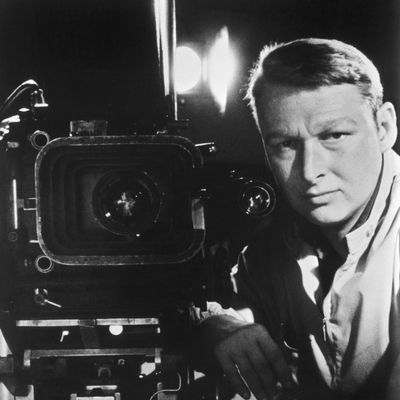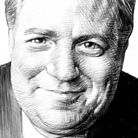
In February 1965, Mike Nichols was a rising stage-director best known as half of the comedy team of Nichols & May, the riotous byproduct of his and Elaine May’s collision as early members of the pioneering Chicago improv troupe the Compass Players. He was 33 years old. I was a 15-year-old high-school student working as a part-time ticket-taker at the National Theatre in Washington, D.C., then a busy Broadway tryout house in the day when new plays were tweaked or overhauled on the road rather than in previews in New York. The National’s new attraction was The Odd Couple, Neil Simon’s third Broadway play. It had a middling advance sale. The stars were Art Carney, whose luster had faded a bit since his heyday as Jackie Gleason’s sidekick on television’s The Honeymooners in the 1950s, and Walter Matthau, a longtime character actor whose career had never taken off.
The play opened in Washington to less-than-full houses, but the local reviews were raves, and soon Washingtonians started storming the box office. To this day, I believe that Nichols’s staging of The Odd Couple is the single funniest production of anything I’ve ever seen in the theater, let alone of this particular work. I still remember vividly the choreographed chaos of the opening poker scene, where the players are trying to pay attention to their hands even while fretting that the woebegone, newly separated Felix, more heartbreaking in Carney’s rendition than in any to follow, might commit suicide. Among a wealth of intricate detail, Nichols somehow created an effect where the opening of an overheated beer can produced a gusher that miraculously crested in an arc under the proscenium arch before landing on the other side of the stage.
Not the least of the virtues of being a ticket-taker was that I could go back every night for free. Which I more or less did. I stood in the back of the house trying to figure out how the damn show worked. I can’t say that I succeeded. But I did learn something else during the two-week run — about what it means to be a perfectionist as an artist. No matter how much audiences were laughing, no matter how rousing the nightly ovations, Nichols and Simon kept working on the play, mining its every ounce for improvements, however tiny. My guess is that if they had done nothing at all, The Odd Couple still would have been the enormous hit that it was to become on Broadway that March, and the American classic that endures to this day. But every night they made more changes — new bits of business, new lines, even new scenes. They kept shuffling the appearances of the two female supporting characters, the neighboring Pigeon sisters, until they alighted on a whole new denouement in the final weekend. To my astonishment, they perfected a show that my young self and perhaps everyone else in the audience had judged plenty perfect already.
Such was the propulsion of The Odd Couple that it catapulted Nichols to Hollywood. His first two movies, Who’s Afraid of Virginia Woolf? and The Graduate, completed in the next two years, were a directing debut like few others in the history of American film. What would follow was a career also like few others, a nearly nonstop progression of both screen and stage projects. His role model was Elia Kazan, a hero to Nichols from the moment he, in his own high-school theatergoing days, attended the second-night performance of the original production of A Streetcar Named Desire at the Barrymore Theatre in 1947. It was at the Barrymore, pointedly, that Nichols paid homage to Kazan with his rending production of Death of a Salesman, both his final triumph and Philip Seymour Hoffman’s, just two years ago.
Not every Nichols production was great. The first time I met him was in 1975, when, as a fledgling magazine writer, I spent days on the Culver City lot where he was shooting The Fortune, a seemingly can’t-miss period comedy starring Jack Nicholson and Warren Beatty. It missed by a mile, an outcome that seemed apparent to Nichols as well. But again, as I could now see in close-up, he was relentless in trying to fix it, never forsaking his urbane optimism and preternatural calm. As befit a former performer, he showed extraordinary patience with actors, including at least one who had a habit of turning up late and not always in peak condition.
Nichols didn’t like my piece about the making of that movie, and in the years to come, my published opinions of his film and stage ventures were highly variable. But once I left the reviewing business two decades ago, I got to know him through mutual friends and ever since have had the good fortune of being able to ask him the million questions I wanted to ask — whether about Nichols & May routines (still priceless), or the revisions he induced Tom Stoppard to make in The Real Thing for its Broadway premiere in 1984, or the choices he made in his television adaptation of Angels in America. Along with Virginia Woolf and Kazan’s film of Streetcar, Angels is one of the only screen versions of a contemporary American play to harness the power of the theatrical original.
Last spring, I started spending more time with Mike than ever before. At the impassioned suggestion of the director (and fellow Stoppard specialist) Jack O’Brien, a close Nichols friend, I embarked on producing a documentary about him for HBO. Mike had never tried to write an autobiography, despite an extraordinary life that began with his childhood escape from Hitler’s Germany and that spanned golden ages of 20th-century show business in Chicago, New York, and Hollywood. He knew everyone, was interested in everything, and had been present at all sorts of unexpected events: He and Elaine May were standing behind Marilyn Monroe at the fund-raiser where she sang “Happy Birthday” to Jack Kennedy — howling at the spectacle of her dress ripping up her back. But Mike was not one given to public introspection; he was unfailingly modest about himself and generous about his collaborators; he disdained gossip. He was not a natural memoirist.
Still, he agreed to sit down for three long conversations on camera with his friend Jack. Though he looked a bit frail, a matter of concern to all around him, he was as active as always both personally and professionally, preparing to direct Meryl Streep in a HBO film adaptation of Terrence McNally’s Master Class early next year. In his exchanges with Jack, he was as witty and sharp as everyone would expect Mike Nichols to be. One of the conversations took place before a packed house at the Golden Theatre on 45th Street last July. It was the same stage where An Evening With Mike Nichols and Elaine May had been a smash hit, running nine sold-out months, 54 years earlier. It’s entirely possible that the team of Nichols & O’Brien got nearly as many laughs as its predecessor. Sitting in the back of the house with the documentary’s director Doug McGrath, I could hardly fathom the joy. Very few things in life or art remain constant for a half-century, but for me, Nichols’s particular brilliance was one of them. After the performance was over, we repaired with some of our nearest and dearest to Bar Centrale, and such was Mike’s energy that we practically closed the joint down.
The shock of his sudden death, not to mention the grief, is just settling in. As it happened, Doug finished a cut of our film yesterday. The plan was to show it to Mike right after Thanksgiving. We were eager for him to see it most of all because he’d have countless ideas about how to improve it. In that, at least, we were like everyone who came before us — delirious over the prospect of being directed by Mike Nichols.
*This article appears in the December 1, 2014 issue of New York Magazine.


